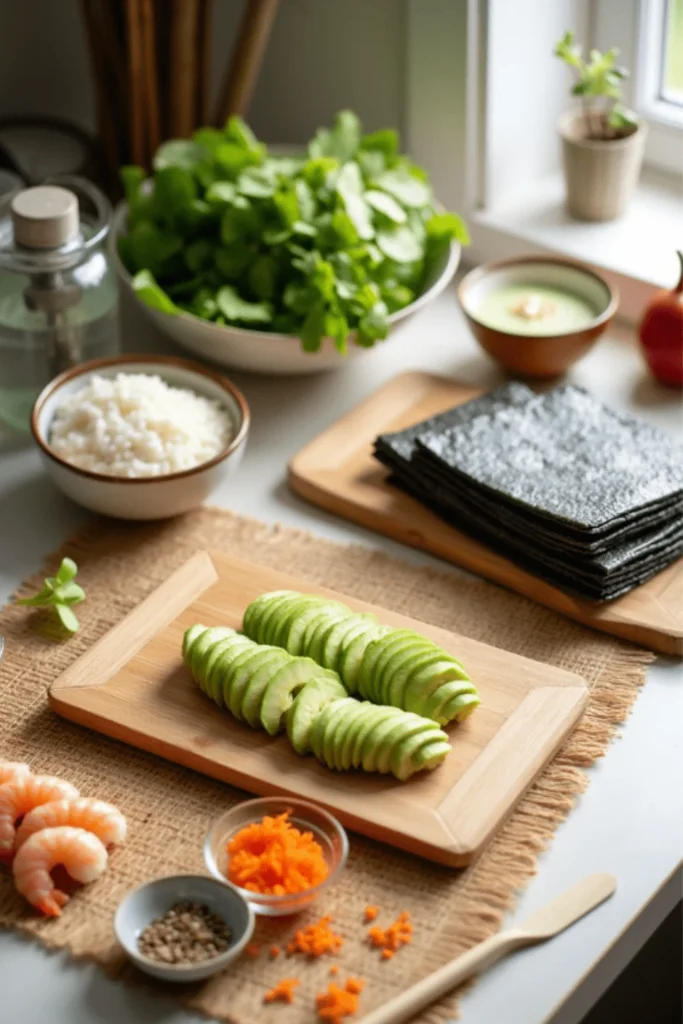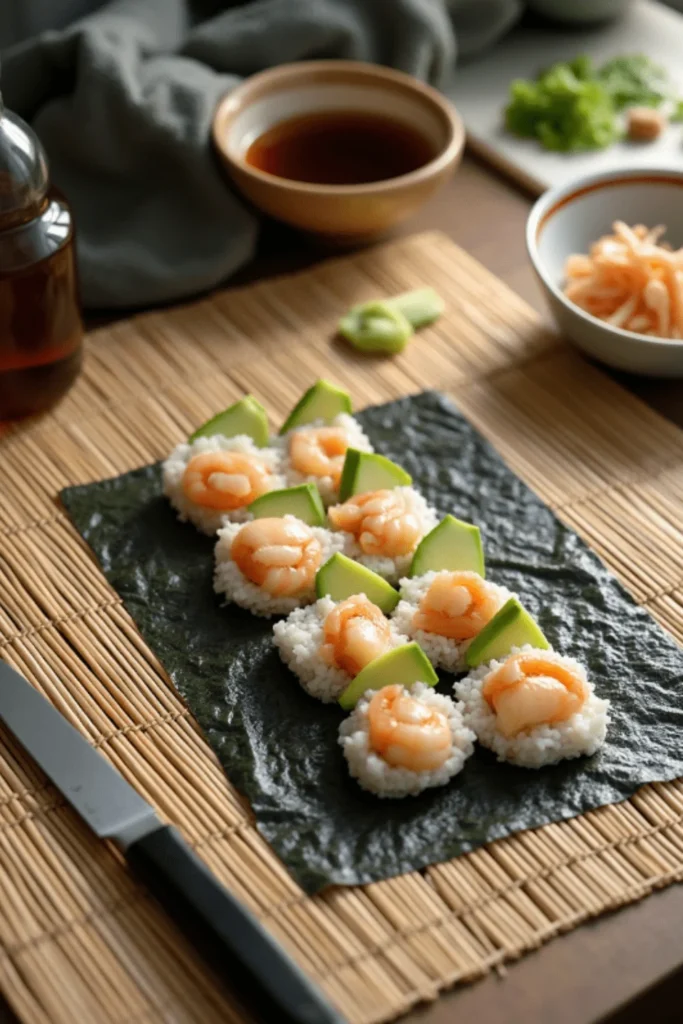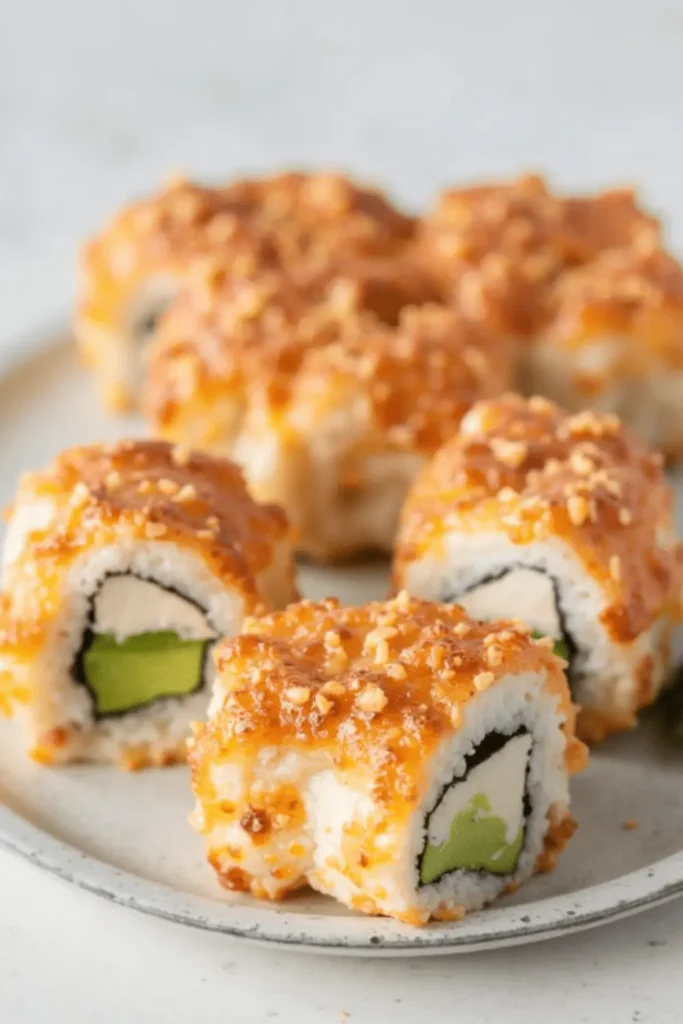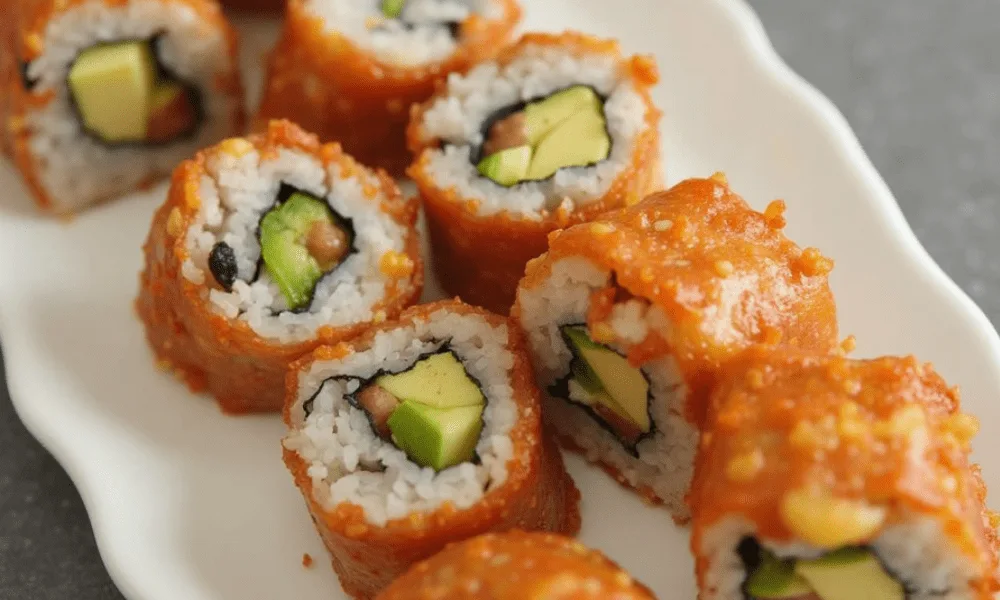Have you ever wanted to try sushi but didn’t know where to start? The Boston Roll is the perfect introduction! With tender cooked shrimp, creamy avocado, and crisp cucumber wrapped in soft rice and nori, it’s simple, fresh, and beginner-friendly. In this article, we’ll explore everything about this delicious roll, from its ingredients to how you can make it at home. Let’s get started!
What is a Boston Roll?
The Boston Roll is a sushi roll that’s simple, delicious, and perfect for beginners. Unlike traditional sushi with raw fish, it uses tender, cooked shrimp, making it a friendly option for everyone.
Paired with creamy avocado, crisp cucumber, and soft sushi rice, each bite is a perfect mix of flavors and textures. Sometimes, it’s topped with sesame seeds or fish roe for a little extra crunch and color.
The name “Boston Roll” comes from its popularity in Boston, where chefs created this sushi to suit local tastes. It’s a fun, modern twist on classic Japanese sushi—perfect for anyone looking to try something fresh and tasty!
Ingredients of a Boston Roll

An assortment of fresh ingredients for making Boston Roll sushi, featuring avocado, shrimp, rice, nori sheets, and shredded carrots
The magic of the Boston Roll lies in its simple yet flavorful ingredients. Every element is carefully chosen to create a delicious combination of taste and texture. Let’s take a closer look at what makes this roll so special.
At the heart of the Boston Roll is cooked shrimp. Tender and slightly sweet, the shrimp stands out, giving the roll its signature flavor. For many, this cooked option makes sushi feel more approachable, especially for those who aren’t fans of raw fish.
Next comes the creamy avocado. Its smooth, buttery texture adds richness to every bite. When paired with the crisp, refreshing crunch of cucumber, it creates a balance of fresh and savory flavors that’s simply irresistible.
Of course, no sushi roll works without nori and sushi rice. The nori, or seaweed, wraps snugly around the ingredients, holding everything together like a delicious blanket. The sushi rice, lightly seasoned with vinegar, adds a slightly tangy taste that perfectly complements the other ingredients.
To finish, Boston Rolls often feature simple yet delightful toppings. Chefs frequently sprinkle sesame seeds over the roll, adding a subtle nuttiness and a satisfying crunch. Others choose to use fish roe, called tobiko, which adds a pop of color and a tiny burst of salty flavor that enhances the overall experience.
Here’s a quick list of the core ingredients in a Boston Roll:
- Cooked shrimp
- Avocado
- Cucumber
- Nori (seaweed)
- Sushi rice
- Sesame seeds or tobiko (optional)
Each ingredient plays a key role, coming together to create a sushi roll that’s fresh, flavorful, and fun to eat. Whether you’re making it at home or ordering it at a restaurant, these simple ingredients promise an unforgettable treat! So why not try it today? You won’t regret it!
How to Make a Boston Roll at Home

Step-by-step Boston Roll preparation with shrimp, avocado, and rice on nori sheets, ready to be rolled into sushi.
Making a Boston Roll at home might sound tricky, but with a little practice, it’s easier than you think! Plus, it’s a fun activity for family or friends, and the reward is a delicious homemade sushi roll. Let’s walk through the process step by step.
The first step is preparing the sushi rice, which forms the base of any good sushi roll. Start by rinsing the rice thoroughly under cold water until the water runs clear. This removes excess starch and ensures the rice doesn’t turn too sticky. Next, cook the rice according to the package instructions. Once it’s done, let it cool slightly before gently mixing it with sushi vinegar. This gives the rice its signature tangy flavor. Spread it out on a plate to cool while you prepare the other ingredients.
Now, it’s time to assemble the Boston Roll. Lay a sheet of nori (seaweed) shiny side down on a bamboo rolling mat. Wet your hands slightly to prevent sticking, then spread a thin layer of sushi rice evenly over the nori. Leave about an inch of space at the top edge of the sheet to help seal the roll later. Add the cooked shrimp, avocado slices, and cucumber sticks in a neat row across the middle of the rice.
The fun part is rolling the sushi. Using the bamboo mat, gently roll the nori away from you, pressing firmly but not too hard. Keep rolling until the edges seal, creating a tight, even roll. If needed, wet the top edge of the nori to help it stick together.
Here are a few quick tips for perfecting your Boston Roll:
- Keep your hands damp to prevent rice from sticking.
- Use fresh, high-quality ingredients for the best flavor.
- Don’t overfill the roll to avoid it falling apart.
Once your roll is ready, slice it into bite-sized pieces with a sharp knife. Serve it with soy sauce, pickled ginger, and a dollop of wasabi, and enjoy your homemade masterpiece!
Boston Roll vs Other Sushi Rolls

Mouthwatering Boston Roll sushi filled with avocado and cream cheese, topped with a golden crispy coating.
The Boston Roll is one of many sushi rolls that have found their way into hearts (and stomachs!) around the world. But how does it compare to other popular rolls, like the California Roll, or even traditional Japanese sushi? Let’s break it down.
First, let’s talk about the California Roll. These two rolls might seem similar because they both use avocado and cucumber, but there’s one key difference: the protein. While the Boston Roll uses cooked shrimp, the California Roll features imitation crab. This gives the Boston Roll a slightly lighter, fresher flavor, while the California Roll is richer and slightly sweeter. Both are fantastic choices, but if you prefer shrimp, the Boston Roll is your winner!
Next, let’s compare the Boston Roll to traditional Japanese sushi. Traditional sushi often focuses on raw fish, like tuna or salmon, and uses fewer ingredients to let the fish shine. In contrast, American-style rolls, like the Boston Roll, include cooked proteins and extra fillings, such as avocado and cucumber. This makes them more approachable, especially for people new to sushi.
Another big difference is the style of presentation. Traditional sushi is often minimalist, highlighting the fish and rice. American-style rolls, on the other hand, tend to be more creative, with toppings like sesame seeds, fish roe, or even spicy mayo. The Boston Roll follows this trend, offering a fun twist on classic sushi traditions.
Here’s a quick comparison:
- Boston Roll: Cooked shrimp, avocado, cucumber, sesame seeds, approachable for beginners.
- California Roll: Imitation crab, avocado, cucumber, slightly sweeter.
- Traditional Sushi: Focuses on raw fish, simpler presentation, fewer ingredients.
In the end, the Boston Roll is a fusion of cultures—blending traditional sushi techniques with flavors that suit modern tastes. It’s a roll that welcomes everyone to the sushi table!
Common Mistakes When Making a Boston Roll
Making a Boston Roll at home is fun, but it’s easy to run into a few common mistakes along the way. Don’t worry, though—these errors are easy to fix with a little practice and the right tips!
One of the most common mistakes is overpacking the ingredients. It’s tempting to add extra shrimp, avocado, or cucumber for more flavor, but too much filling makes it almost impossible to roll the sushi properly. Instead, keep it simple and stick to small, evenly cut portions. This ensures the roll stays tight and doesn’t fall apart when you slice it.
Another common issue is rolling mistakes. If the roll isn’t tight enough, it can unravel or lose its shape. To avoid this, use a bamboo rolling mat and press gently but firmly as you roll. Make sure to tuck the ingredients in as you go to create a compact roll. If the nori doesn’t seal at the edge, wet it lightly with water to help it stick.
Using improper rice or nori sheets can also cause problems. Sushi rice needs to be the right texture—soft and sticky but not mushy. Be sure to rinse the rice thoroughly before cooking and season it with sushi vinegar for the best flavor. Similarly, make sure to use high-quality nori sheets. If the nori is too thin, it can tear during rolling, so opt for thicker, premium sheets to make things easier.
Here are some quick tips to avoid these mistakes:
- Don’t overfill: Stick to small portions for even rolling.
- Roll tightly: Use a bamboo mat and press gently.
- Use the right ingredients: Proper sushi rice and quality nori make a big difference.
With a little patience and these tips in mind, you’ll be rolling perfect Boston Rolls in no time!
Tips for Buying Fresh Ingredients
The secret to a delicious Boston Roll starts with fresh, high-quality ingredients. Knowing how to pick the best shrimp, avocado, cucumber, and nori sheets can make all the difference. Let’s explore how to shop for the perfect ingredients!
When buying shrimp, always choose fresh or frozen shrimp that are firm and smell clean, like the ocean. Avoid shrimp that have a strong fishy odor or feel slimy, as this can be a sign they’re no longer fresh. Cooked shrimp works best for Boston Rolls, so look for pre-cooked shrimp at your grocery store or cook raw shrimp yourself at home. For the best flavor, medium-sized shrimp are ideal since they fit perfectly in the roll.
Next, let’s talk about avocados. A perfectly ripe avocado is essential for the creamy texture Boston Rolls are known for. When shopping, gently press on the avocado—it should be firm but slightly soft to the touch. Avoid avocados with overly soft spots or dark blemishes. If they’re still firm and unripe, you can let them ripen at home in a few days. Don’t forget cucumbers, too! Choose fresh cucumbers that feel firm and have smooth, bright green skin. Seedless cucumbers or English cucumbers work best because they have fewer seeds and a mild, crisp flavor.
Finally, let’s not overlook the nori sheets. High-quality nori is key to rolling sushi successfully. Look for nori that’s dark green or black, shiny, and crisp. Lower-quality nori may look dull or feel brittle, making it harder to work with. Specialty Asian markets or online stores often sell premium nori sheets that are perfect for sushi.
Here’s a quick checklist for fresh ingredients:
- Shrimp: Firm, clean-smelling, and pre-cooked.
- Avocado: Slightly soft with no blemishes.
- Cucumber: Firm, smooth, and preferably seedless.
- Nori Sheets: Dark, shiny, and crisp.
With these tips, you’ll always bring home the freshest ingredients for your Boston Roll. Fresh ingredients mean better flavor, so take your time when shopping!
Frequently Asked Questions About Boston Roll
Can Boston Rolls be made with raw fish?
Yes, you can use sushi-grade raw fish like tuna or salmon instead of cooked shrimp, but the traditional Boston Roll uses cooked shrimp.
Are Boston Rolls gluten-free?
They can be! Use gluten-free soy sauce and check that your sushi vinegar is gluten-free. The main ingredients are naturally gluten-free.
How do I store leftover Boston Rolls?
Wrap them tightly in plastic wrap, place them in an airtight container, and refrigerate. Eat them within a day for the best taste!
Explore More Delicious Ideas
If you’re a fan of the Boston Roll, why not explore other seafood-inspired recipes? Our lox bagel recipe is a must-try for a perfect blend of flavors. For those looking to elevate their sushi nights, don’t miss our guide to snow crab legs—a delightful pairing option that brings a touch of elegance to your table. Dive into these recipes and let your taste buds embark on a flavorful adventure!
The Boston Roll is more than just a sushi roll—it’s a delightful blend of flavors that feels welcoming for everyone. From its cooked shrimp and creamy avocado to its crisp cucumber and perfect rice, it’s designed to be approachable, fresh, and fun. Whether you’re comparing it to other rolls, learning to make it at home, or picking out fresh ingredients, the Boston Roll always stands out for its simplicity and taste.
So, why not give it a try? Whether you enjoy it at a restaurant or roll it yourself, the Boston Roll is a reminder that sushi can be easy, delicious, and perfect for sharing. It’s a roll you’ll want to come back to again and again!


